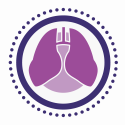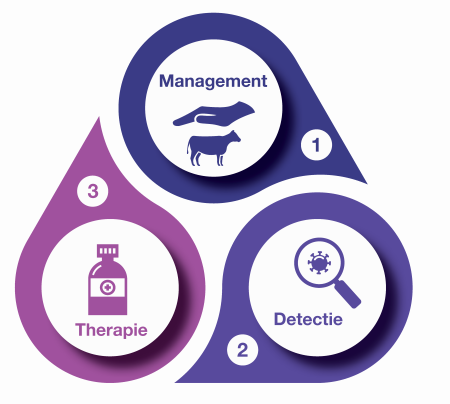- M. Stöber (2006): “Krankheiten der Atmungsorgane, des Zwerchfells und der Brustwand.” in G. Dirksen, H.-D Gründer, M. Stöber, et al., eds. Innere Medizin und Chirurgie des Rindes. 5th ed. Parey in MVS Medizinverlage Stuttgart GmbH & Co. KG 2006, pp. 271-356.
- Pardon, B., De Bleecker, K., Hostens, M. et al. “Longitudinal study on morbidity and mortality in white veal calves in Belgium.”; BMC Vet Res 8, 26 (2012).
- Abuelo A., Cullens F., Brester J.L. 2021. Effect of preweaning disease on the reproductive performance and first-lactation milk production of heifers in a large dairy herd. Journal Dairy Science (104), p. 7008-7017.
- Pardon B., Callens J., Maris J., van Praet W., Deprez P., Ribbens S. 2020. Pathogen-specific risk factors in acute outbreaks of respiratory disease in calves. Journal Dairy Science (103), p. 2556 – 2566.
- Mijares et al. (2023) “Veterinarians” perspectives of pain, treatment, and diagnostics for bovine respiratory disease in preweaned dairy calves. Front. Pain Res. 4:1076100.
- B. Pardon et S. Buczinski, (2020): “BRD Diagnosis What Progress Has Been Made in Infectious Diagnosis?”.
- Antonis A. F. G. et al. (2022): “Respiratory pathogens in veal calves: Inventory of circulating pathogens”; Veterinary Microbiology 274, (2022) 109571.
- MS. Martin et al. (2022): “Assessment of pain associated with bovine respiratory disease and its mitigation with flunixin meglumine in cattle with induced bacterial pneumonia.”
Bovine respiratory disease (BRD):
een complexe aandoening, een complexe uitdaging
Wat is BRD?
Bovine Respiratory Disease (BRD), ook bekend als enzootische bronchopneumonie of transportkoorts (Shipping Fever), treedt vooral op bij het transporteren en samenbrengen van grote groepen recent gespeende kalveren.
BRD is een overkoepelende term voor aandoeningen aan de bovenste en onderste luchtwegen.1 De hoogste incidentie van BRD wordt meestal geassocieerd met transport of met het samenbrengen van dieren tijdens of na het spenen. Klinische symptomen treden 1 tot 2 weken na het initiële incident op, met een potentiële morbiditeit van meer dan 80%.1
BRD is verantwoordelijk voor ongeveer een kwart van de kalversterfte en een groot deel van het antibioticagebruik bij kalveren.2 Het is een multifactoriële aandoening met een grote economische impact, niet alleen tijdens de klinische ziekte maar gedurende het hele leven van het dier.3
Daarom zijn vroege detectie en behandeling, samen met correcte preventieve maatregelen, essentieel om een goede dierenwelzijn te waarborgen. Epidemische luchtwegaandoeningen pieken in de winter en zijn voornamelijk van virale oorsprong.4

Is BRD een pijnlijke aandoening?
De meeste dierenartsen beschouwen BRD als een milde tot matig pijnlijke aandoening.5 Het herkennen van pijn bij runderen is erg lastig, omdat deze dieren van nature stoïcijns zijn en de tekenen van pijn vaak verbergen. Om de beoordeling van pijn te ondersteunen, zijn enkele methoden ontwikkeld.
file_download Lees hier hoe u pijn bij rundvee kunt detecteren en controleren
Wat zijn de symptomen van BRD?
Om je te helpen bij het beoordelen van de gezondheid van dieren hebben we een checklist ontwikkeld.

Welke pathogenen worden geassocieerd met BRD?
BRD kan worden veroorzaakt door een infectie met één of meerdere ziekteverwekkers. Luchtwegaandoeningen pieken in de wintermaanden en zijn voornamelijk van virale oorsprong, hoewel zowel virussen als bacteriën geassocieerd kunnen worden met BRD.1,2
Luchtweginfecties door virussen (zoals BRSV, BHV-1 of het Parainfluenza-virus type 3) of bacteriën, zoals Mycoplasma bovis zijn vaak sluipend en vertonen weinig klinische symptomen. Deze pathogenen beïnvloeden lokale immuuncellen, wat leidt tot hun gevaarlijkste effect: immuunsuppressie, waardoor het kalf vatbaarder wordt voor infecties met opportunistische bacteriën.1
Wanneer deze pathogenen in een dier worden aangetroffen, kunnen ze direct als veroorzaker van BRD worden beschouwd, aangezien ze niet aanwezig zouden moeten zijn in gezonde kalveren.1
Bacteriële ziekteverwekkers zoals Mannheimia haemolytica, Pasteurella multocida of Histophilus somni worden vaak geassocieerd met de meer acute gevallen van BRD. Deze bacteriën veroorzaken waarschijnlijk niet op zichzelf de ziekte, omdat ze ook vaak bij gezonde dieren worden aangetroffen.4,6,7
Aangezien het belangrijk is om antibiotica verantwoord te gebruiken, is er een groeiende behoefte aan monsters van de diepe luchtwegen om de veroorzakende pathogenen en hun gevoeligheid te bepalen voordat met de behandeling wordt gestart.

Waarom zijn runderen zo vatbaar voor luchtwegaandoeningen?
Het begrijpen van de natuurlijke aanleg van runderen voor aandoeningen aan de onderste luchtwegen, is van groot belang voor het verloop van het ziekteproces en de impact die luchtwegaandoeningen op kalveren kunnen hebben:

add
De longen volgroeien laat en vaak is de fysiologische ontwikkeling voltooid rond de
12-13 maanden.1

add
De verhouding van gasuitwisselingsoppervlak tot het lichaamsgewicht is erg ongustig.

add
Runderen hebben meer interstitieel weefsel in de longen, wat de flexibiliteit van het longweefsel beperkt.

add
Runderen vertonen een fibrineus ontstekingspatroon: ze reageren op weefselschade door fibrineus exsudaat te produceren, wat zorgt voor een snelle littekenvorming van de schade. Het beschadigde weefsel kan minder snel terugkeren naar zijn oorspronkelijke staat.

add
Runderen hebben een lagere thermoneutrale zone dan mensen. Daardoor zijn ze gevoeliger voor hittestres. Respiratoire problemen versnellen dit proces.
Wat zijn de risicofactoren van BRD?
BRD is een complexe ziekte die wordt bevorderd door vele factoren met betrekking tot het dier, de circulerende ziekteverwekkers en de huisvestingsomstandigheden. Onder optimale omstandigheden zijn al deze factoren in evenwicht, wat het uitbreken van de ziekte voorkomt.
Management
- Stress
Stress speelt een cruciale rol in de immuuncompetentie van een dier. Transport, spenen, voeding, groeperen, scheiding van het moederdier en zoötechnische procedures zoals onthoornen en castratie verhogen het stressniveau van kalveren. Omgevingsstressoren zijn belangrijke factoren die de ziekte veroorzaken. Daarom is goed kuddebeheer (adequate voeding, huisvesting, klimaat, biestregime) belangrijk. - Tijd van het jaar
In Europa is aangetoond dat BRD gerelateerde ziekteverwekkers het meest gediagnosticeerd worden tussen de herfst en de lente.² De epidemische ziekte piekt in de wintermaanden.² In deze periode wordt zelfs grazend vee binnen gehuisvest, waardoor de bezettingsdichtheid toeneemt of er meerdere leeftijdsgroepen in één stal aanwezig zijn. - Klimaat
De klimaatomstandigheden in deze periode kunnen ook uitdagend zijn. Zorg ervoor dat kalveren altijd in een droge omgeving worden gehuisvest met voldoende strooisel. Het waarborgen van voldoende verse luchttoevoer terwijl tocht rond de dieren wordt vermeden, kan een uitdaging zijn.
Hoe wordt BRD gediagnosticeerd?
Het herkennen van de eerste symptomen van BRD is cruciaal voor een succesvol behandelplan en ter voorkoming van verdere infecties. Vroege detectie kan lastig zijn, aangezien kalveren niet meteen duidelijke klinische symptomen vertonen. Als de besmette kalveren niet op tijd worden opgemerkt, kunnen ze ernstig ziek worden met een hoog sterftecijfer tot gevolg.
Als er al infecties zijn op een bedrijf en een kuddebrede infectie dreigt, dan kan het uitvoeren van autopsies een handig hulpmiddel zijn om de situatie onder controle te krijgen.4
Als vuistregel geldt dat hoe eerder diagnostische monsters worden genomen, hoe groter de kans is dat het veroorzakende pathogeen wordt geïsoleerd.6
Er zijn verschillende bemonsteringsmethoden beschikbaar, waarvan diepe nasofarynxswabs, transtracheale spoelingen en niet-endoscopische broncho-alveolaire lavage (nBAL) zijn aanbevolen, maar deze worden regelmatig niet overwogen.5
Naast de klassieke bacteriële kweek en gevoeligheidstests worden PCR-tests ook steeds populairder. PCR kan voordelig zijn om te screenen op veel verschillende ziekteverwekkers (zowel bacteriën als virussen) en de hoge gevoeligheid maakt het mogelijk om geclusterde monsters te onderzoeken.
Deze video toont een voorbeeld van een diagnostische aanpak. Zoals eerder vermeld is dit één van de methoden die een dierenarts kan gebruiken voor het uitvoeren van een transtracheale spoeling.

Hoe kan BRD behandeld worden?
Antimicrobiële therapie wordt vaak gebruikt vanwege de aanwezigheid van bacteriën bij BRD. Het succes van antibioticabehandelingsprotocollen hangt af van het tijdstip van de behandeling, de identificatie van de ziekteverwekker en de gevoeligheid ervan. Tijdens een enquête onder dierenartsen beschouwden alle respondenten BRD-infecties bij kalveren minimaal als licht piijnlijk.5
Het gebruik van een NSAID als aanvulling op antimicrobiële therapie draagt bij aan een snellere daling van de lichaamstemperatuur en een beter herstel.8
Het is aanbevolen om een ondersteunende behandeling toe te passen, dat wil zeggen mucolytica om de ademhaling te vergemakkelijken door de spieren in de longen te ontspannen en de luchtwegen te verbreden. Voldoende en hoogwaardige voeding ondersteunt het herstel. Daarnaast is het scheiden van zieke dieren van gezonde huisgenoten ook zeer relevant om de infectieketen te doorbreken en de rest van de kudde te beschermen.
Hoe beïnvloedt BRD het dierenwelzijn en de bedrijfsprestaties?
Studies hebben aangetoond dat BRD verantwoordelijk is voor bijna een vierde van de kalversterfte.2
- Directe kosten zijn gerelateerd aan productieverliezen op bedrijfsniveau door sterfte, verminderde karkaskwaliteit, behandelingskosten en arbeidskosten.
- Indirect heeft BRD invloed op de fokprestaties van de kudde.
Verminderde vruchtbaarheid
Kalveren met een BRD-verleden hebben een lagere gewichtstoename, wat uiteindelijk kan leiden tot een lager lichaamsgewicht op de leeftijd van 14 maanden (+/- 24 kg minder dan gemiddeld). Als gevolg daarvan bereiken ze de geslachtsrijpheid later. De afkalfleeftijd is ongeveer 0,5 tot 6 maanden later, de leeftijd van de 1e inseminatie is tot 20 dagen later en tijdens het afkalven is er een hoger risico op dystocia.3
Lagere melkgift
Kalveren met een ernstige BRD-infectie in de eerste 3 levensmaanden produceren 150 kg minder melk in de 1e lactatie. Kalveren met een milde BRD-infectie in de eerste 6 levensmaanden produceren gemiddeld 110 kg minder melk.3
Hogere afvoerpercentages
Het risico op vroegtijdige afvoer is hoger bij kalveren met een BRD-verleden.3
5 Belangrijke punten om te onthouden
- BRD bij kalveren is een pijnlijke aandoening die een effectieve pijnbestrijding vereist.5
- BRD is een multifactorieel probleem - het ontstaan hangt af van de aanwezigheid van de veroorzakende ziekteverwekker, de algemene conditie van het dier en bedrijfsomstandigheden.
- Anatomisch gezien zijn runderen vatbaarder voor ademhalingsziekten.1
- De economische impact van BRD is aanzienlijk. Meerdere studies hebben aangetoond dat BRD verantwoordelijk is voor bijna een vierde van de kalversterfte.2,8
- BRD vereist een geïntegreerde aanpak.
Auteurs
Aleksandra Krawczyk, DVM
Technical Manager Cattle
Dechra Veterinary Products

Matthias Riedel, DVM
Business Manager Cattle and Vaccines
Dechra Veterinary Products

Referenties add
Downloads
Videos
Interne geneeskunde producten
lock Log in op uw Dechra account
account_box Nog geen account?
Registreer je nu om toegang te krijgen
- Volledige product- en ziektespecifieke informatie
- Gratis ondersteunend materiaal en video's
- Dechra Academy: ons GRATIS e-learning platform


